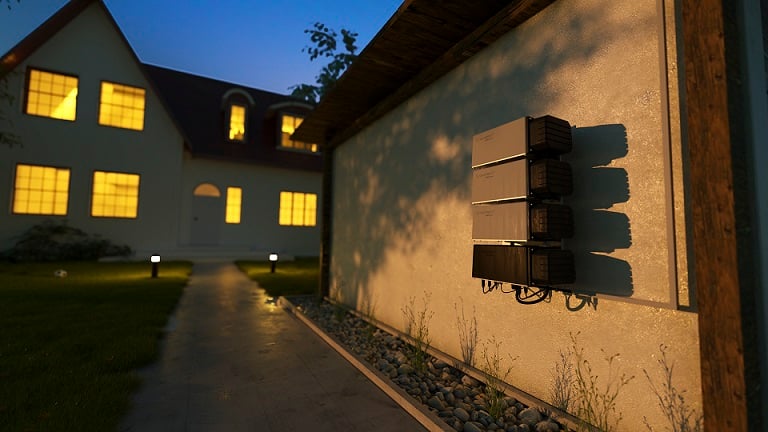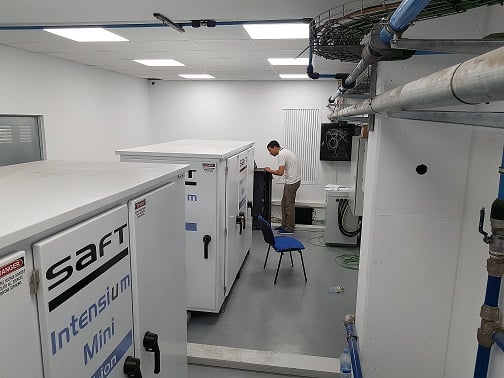Europe’s energy storage sector delivered around 600MWh of installed capacity in 2017, a rise of 49% on the previous year. Another big push is expected in 2018, as reported by Energy-Storage.news from EMMES 2.0 – the second half-yearly edition of the European Market Monitor on Energy Storage.
In the second part of our interview with Valts Grintals, analyst at Delta-ee and the report’s lead author, we discuss why behind-the-meter energy storage, including commercial and industrial (C&I) and residential installations, contributed so much to the market’s recent success.
We looked at front-of-meter storage last time out, but what’s the story behind-the-meter. We have heard already that Germany exceeded expectations for residential sales, hitting 37,000 units, but what are some of the market dynamics behind that?
Energy storage is becoming a better-known technology by customers and the business models are playing a huge part in that. A lot of them are tailored specifically to a German homeowner.
Try Premium for just $1
- Full premium access for the first month at only $1
- Converts to an annual rate after 30 days unless cancelled
- Cancel anytime during the trial period
Premium Benefits
- Expert industry analysis and interviews
- Digital access to PV Tech Power journal
- Exclusive event discounts
Or get the full Premium subscription right away
Or continue reading this article for free
There’s still the KfW subsidy scheme [as well] but our research shows that not a lot of people go through the whole process to get that subsidy, which is not that significant anyway, and instead just buy the battery. Most people buying a PV system are buying storage as well. As a bundle it’s expensive but you get self-consumption, energy independence and peace of mind, which can be played up [as a consumer proposition] in the German market and has contributed to good growth.
We are [however] seeing most of the players who have this specific business model in Germany, and maybe in Austria and Switzerland, having trouble doing the same thing in other markets. It’s been working great in Germany but outside of that, players are still working out what to do with the business model because the home and the homeowner are not the same as in the German market.
We know virtual power plants (VPPs) are being offered, both at retail and distribution and planned community or trial basis. How prevalent are these and are they an impetus to drive sales? Is there much visibility on that part of the market yet?
If you look at market shares, LG Chem is just behind Sonnen in Germany [for sales] and those batteries are just being installed as ‘one-offs’.
Looking at other systems such as Senec, E3DC, sonnen, Solarwatt – whose batteries are being sold with E.On’s Solar Cloud – the majority of those systems are coming in as some kind of bundled [aggregated] offering. Whether it’s the SonnenCommunity, Senec Cloud or the E.On Solar Cloud.
At the moment it’s more of a marketing tool. None of them are really doing peer-to-peer (P2P) trading in terms of aggregation and providing grid services to the extent that they’d want to. It’s really about bundling together an electricity contract, battery and PV system.
It makes it simpler for the customer and allows whoever is providing the system or service to have long-term contracts and ‘stickier customers’. Customers are paying a subscription fee to have a battery. It’s very popular because there’s a lot of non-monetary value in being part of the community or the cloud. So if you’re getting a solar system, you might as well join one of these programmes.

From the providers’ point of view, if they’ve created a cloud or aggregation platform with VPP properties, will they want to sign up pretty much all of their customers to it by default? Is there going to be much interest in standalone systems in BTM residential settings going forward?
If you look at the economics, they do sell a system and they do make a margin from the subscription fee but it’s not hugely profitable to do that. Once you reach that scale and once you are able to frequently provide certain services and get value from it, that’s the end goal. There are other things to consider like upsell opportunities. If you have a loyal customer base and you start selling EV chargers there’s an easy opportunity there, which shouldn’t be forgotten in addition to getting value from the VPP itself.
The other residential market that EMMES 2.0 identified as enjoying a big rise in installations was Italy. What have you observed from that market?
It’s an early adopter market for residential especially. They have a subsidy scheme in one region and that’s where most of the systems have been installed. The scheme is quite good if you look at the economics. There’s a tax reduction in addition to subsidies for buying PV and battery systems. It adds up to a payback period of about seven years, which is better than from PV only in those regions. That has worked in a similar way to the KfW subsidy scheme in Germany which has kick-started the market.
Now we see a lot of residential market players entering the market. It’s getting competitive and they’re going in with quite aggressive price points. Sonnen has announced [it is] working with a PV installer to potentially install 20,000 systems, although it’s hard to tell exactly how many of those will be deployed. But announcements like that drive the market [forward] anyway, by creating interest.
If everything goes to plan it will follow a similar pattern to Germany. An ancillary services scheme is being put together and by the end of this year, early next they should have more details on those and how they will be procured. That’s more likely to be positive for energy storage than negative. [Also, due to favourable weather conditions for solar] in Italy you can probably get away with a smaller PV system and smaller battery which helps bring costs down.
You said previously that in 2017 the BTM C&I market finally began to take off in Europe. Where are the opportunities to be found currently?
Germany seems to still be the most exciting market. You can find good customers with good paybacks and you can get a relatively simple installation, because especially down south peak demand charges have gone up, so there’s a good case for getting a battery to reduce peak demand charges.
That’s likely to be the biggest market for C&I energy storage but in both Germany and the UK there was a lot of hype a year ago that C&I storage is a good ‘middle segment’ where you can get BTM baseline values from self-consumption, UPS and then more easily tap into the FTM ancillary services market because they have certain capacity requirements, but then it slowed down after that.
It’s mainly because going from interest to actual installation takes around a year. That’s a typical lead time for discussions. Also, some [customers] will be tied into existing energy contracts, often for a further three years. All of that has played a big role in why the market has been so slow, it’s only starting to take off now and you hear more about projects in UK, Germany, the Benelux countries. The UK and Germany will remain the two biggest markets.
In the Benelux region there’s a few aggregators there, there’s the recent RESTORE project, it’s both BTM C&I and FTM. It’s a communal battery but it’s huge (18MW). But that’s a limited market by size. A lot of the more interesting C&I business models are in Germany and the UK.

One industry representative I spoke with recently said that one interesting aspect of the C&I market, especially in the UK, is that conversations are now taking place directly with the CFO (Chief Financial Officer) of big companies, rather than an energy manager or sustainability adviser. Does this mean there’s now more economic confidence in energy storage?
[Nonetheless] I think in the UK it’s still mainly going through energy managers, who then go to the decision-makers in the business. The C&I customer really needs to be aware of [and educated about] the technology to get a quick installation.
When it comes to business models, in Europe there’s a few different trends emerging that try to make it simpler. There’s ‘storage-as-a-service’, which basically says to the customer “you pay me a monthly fee and I’ll give you savings”. That’s a simple message to get to an energy manager, but there’s a very different segment being targeted with UPS as a reserve service, there’s a lot of potential there, particularly in the Nordics: Eaton is working with an aggregator to offer UPS systems to a datacentre and the UPS system can also provide reserve services, frequency response. UPS is a relatively easy sell to an energy manager.
Then the third trend I’ve seen, to make it simpler or more appealing is to tie in EVs somehow. I guess it’s a ‘sexier’ thing to talk about with energy managers!
As the players in Europe are learning about how the C&I segment works they are building specific business models to target specific customers.
